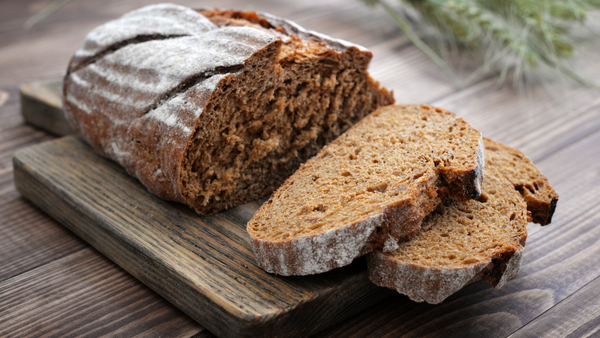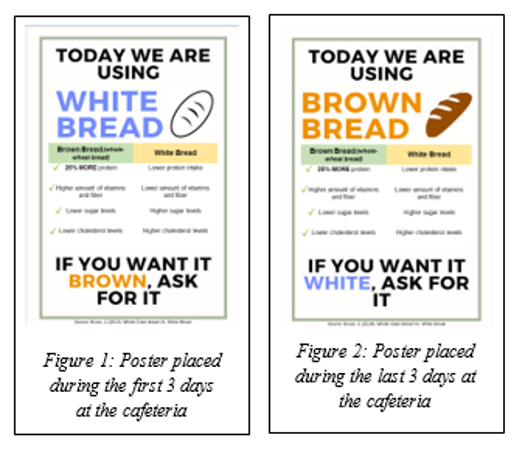Increasing Brown Bread Consumption in a University Cafeteria

Executive Summary
Nudge Lebanon, in collaboration with students from the American University of Beirut (AUB), increased the consumption of brown bread sandwiches at the university’s OXY cafeteria by 82 percentage points, by changing the default bread used to prepare sandwiches from white to brown. Customers were able to switch back to white bread if they wished to do so.
Policy Challenge
Lebanon’s average per capita bread consumption is estimated at 136.8 grams per day, approximately 50 kg per year[1], which is on par with the average per capita bread consumption in the EU. While white bread remains the dominant product in the market, the past five years have seen a growing trend towards “healthy” bread line such as brown or whole-grain bread.[2] Brown bread plays an important role in lowering the risk of chronic diseases, such as coronary heart disease, diabetes, and cancer, as well as contributes to body weight management and gastrointestinal health.[3],[4] It also contains more potassium, calcium, fibers and proteins than white bread.[5]
Despite the national rise in brown bread consumption, customers of the OXY cafeteria at the American University of Beirut (AUB) have been predominantly white bread consumers.[6] With this in mind, Nudge Lebanon, in collaboration with students from the AUB, designed a behavioral insights intervention (nudge) to increase brown bread consumption at OXY cafeteria. The nudge consisted of changing the default bread used to prepare sandwiches from white to brown, with the option to switch to white bread if the customer prefers to do so. Customers were informed about the change in bread type, and that they have the right to switch back to white bread for no extra charge.
Intervention Design
The intervention was implemented as a pretest-posttest (before-after) design, with each period consisting of three days.
During the pretest period, posters were placed is three visible locations inside the cafeteria, indicating that sandwiches were now being prepared with white bread, and that customers could replace it with brown bread if they wished to do so. The posters also stated the benefits of consuming brown bread compared to white bread (Refer to Figure 1).
In the posttest period, the posters were replaced with ones indicating that sandwiches were now being prepared with brown bread, and that customers could replace it with white bread if they wished to do so. In line with the pretest phase, the posters stated the benefits of brown bread relative to white bread (Refer to Figure 2).
Throughout the intervention, customers were asked to place their order first, and then head to the cashier for payment. The cashier would confirm the type of bread with customers before processing their order. Note that the extra charge of LBP 1,000 (US$ 0.66) for brown bread sandwiches was waived by the cafeteria during the intervention.
Survey
Following the conclusion of the intervention, a survey was conducted with customers from OXY cafeteria to find out whether they knew about the intervention, their health perceptions of white and brown bread, and their preference for one over the other.
Results
Data was collected from the cafeteria on a daily basis. The cafeteria manager would share the total number of sandwiches sold along with the type of bread ordered. A total of 405 observations were collected, of which 203 transactions were recorded during the pretest period, and 202 during the posttest period.
Only 8 (3.9%) brown bread sandwiches were consumed in the pretest period compared to 173 (86%) in the posttest period; an increase of 82 percentage points[7].

Survey
A total of 51 responses were collected, of which 28 belonged to male participants and 23 to female participants. According to the survey results, 86% of the customers usually purchased white bread. Of those, only 37.9% knew that they can switch to brown bread.
The survey also revealed that taste is one of the main reasons for not purchasing brown bread, followed by price. Interestingly, the survey revealed that females were more aware of the health benefits from the consumption of brown bread than males.
A majority (61%) of the surveyed participants saw one of the two posters but stated that it did not affect their choice of bread due to taste, habit, and/or price.
Conclusion
Despite claiming otherwise, most customers of the OXY cafeteria do not have strong preferences for one type of bread over the other. Changing the default type bread used to prepare sandwiches had a large and significant effect on the bread type consumed, even when customers were informed that they could replace one type of bread with the other.
This intervention reveals the importance of employing defaults with opt-out mechanisms when promoting healthier eating habits. A replication over a longer duration would enable customers to adapt their behavior to the new default, which could in the long run diminish the observed effects.[8] Moreover, a replication with different food items that may elicit stronger preferences (e.g., French fries vs salad) could also reveal interesting insights about the limits of defaults.
It is worth noting that customers in the pre-test period were not explicitly informed that the price of brown bread was waived throughout the duration of the experiment, which may have led to a reluctance in switching to brown bread (driven by an avoidance to incur extra cost). Accordingly, this may have resulted in overestimation of the observed treatment effects.
[1] Almedawar, M. M., Nasreddine, L., Olabi, A., Hamade, H., Awad, E., Toufeili, I., … & Isma’eel, H. A. (2015). Sodium intake reduction efforts in Lebanon. Cardiovascular diagnosis and therapy, 5(3), 178.
[2] Chbeir, R. & Mikhael, M. (2017). Breaking the bread Market: Lebanon’s Modern Day Bakeries. BLOM Invest, Research Department
[3] Jonnalagadda S.S., Harnack L., Hai Liu, R., McKeown N., Seal, C. et al. (2011). Putting the whole grain puzzle together: health benefits associated with whole grains – summary of American Society for Nutrition 2010. The Journal of Nutrition, 141 (5), 1011S –1022S
[4] Mellen, P. B., Walsh, T. F., & Herrington, D. M. (2008). Whole grain intake and cardiovascular disease: a meta-analysis. Nutrition, Metabolism and Cardiovascular Diseases, 18(4), 283-290.
[5] Frølich, W., & Åman, P. (2010). Whole grain for whom and why? Food & nutrition research, 54(1), 5056.
[6] Based on discussions with the cafeteria management and staff.
[7] These effects may have been inflated, as customers in the pretest period were not informed that switching to brown bread was free.
[8] Customers who were not aware of or did not properly process the change in cafeteria policy, will over time learn that the default bread has changed, and as a result revert back to their preferred bread type (if any).

